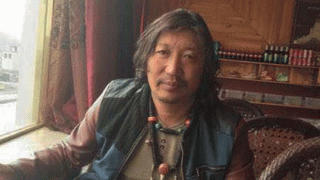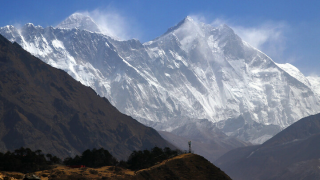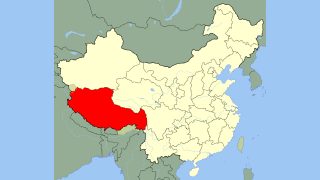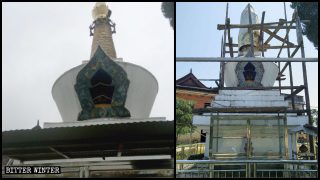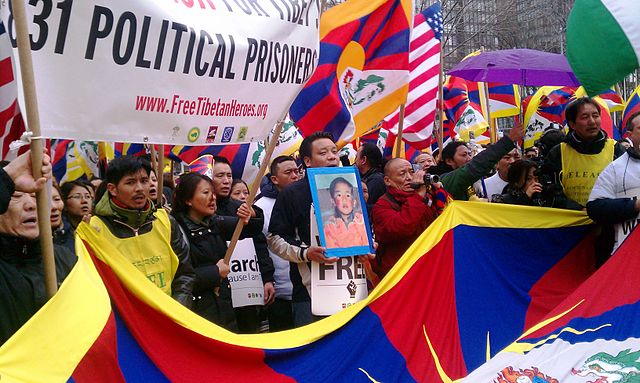
While we celebrate the World Refugee Day, a Tibetan scholar reflects on the history and resilience of 150,000 Tibetan refugees living in exile.
by Tsewang Gyalpo Arya
June 20, 2020 is World Refugee Day. The United Nations designated this day to remember the refugees around the world, and to remind ourselves of how we all could work together to restore the rights and dignity of the refugees. Most of the refugees are the victims of dictatorial or tyrannical regimes. Replacing these regimes with more democratic and responsible governments is the panacea to all the ills and sufferings associated with the refugee problems. Tibet too is a victim of a tyrannical Communist regime. Tibetans in and outside Tibet have suffered and are still suffering under the Chinese Communist regime for the last seventy years.
On this World Refugee Day, let me briefly share the Tibetan refugees story, how Tibetans lost their country and became refugees, their struggle, hope, and future aspirations.
Introduction
Tibet has been a peaceful and independent country since ancient times. It is situated on the highest plateaus of the world, the Pamir and Tibetan plateaus. Therefore, it is also known as the roof of the world, and the source of major rivers of Southeast Asian countries. Geographically, it lies north of India and Nepal, west of China, and south of Mongolia. Nepal and Tibet share Mount Everest, one side of the mountain is in Nepal and the other side is in Tibet. According to the ancient Indian sacred books Rigveda and Atharvaveda, Tibet is Trivistapa, the heavenly abode, with Mount Kailash as the center or navel of the earth.
After the Communists took over China in 1949 as part of their expansionist policy, this peaceful and holy nation was attacked and invaded in 1950. The Dalai Lama, the spiritual and temporal head of Tibet, escaped and sought asylum in India. Some 80,000 Tibetans followed him into exile thereafter.
History
India, Nepal, and Tibet share many historical, cultural, and religious values. Tibet during the 7th to the 9th century has been one of the most powerful military empires in Asia. Tibetan emperors like Srongtsan Gampo (569-650 AD), Khrisong Deutsan (742-798 AD) and Khri-ralpachen (802-841 AD) conquered the territories of the neighboring Central Asia, Nepal, India, and China. Around that time, Buddhism from India also entered Tibet. The Tibetan emperor, Khrisrong Deutsan, invited Indian Buddhist masters such as Shantarakshita and Guru Padmasambhava to Tibet, and made Buddhism a state religion.
Since the adoption and propagation of Buddhism in Tibet, the war-like nature of Tibetan people got pacified, and more and more attention was paid to spiritual development and promotion of peace and harmony, both in the land and around the neighboring countries. Tibet’s military strength dwindled, and spiritual pursuit gained momentum. The number of armies decreased, and the number of monks and nuns increased exponentially. When the modern world was busy exploring physical matters and industrial revolutions, Tibetans were busy exploring deeper into the mind and seeking a spiritual revolution. Many Indian scholars visited Tibet to teach, and many Tibetan scholars visited India to study Buddhism. Military campaigns and territorial aggression stopped, Tibet became peaceful, and the neighboring countries began to look to Tibet for spiritual guidance and enlightenment.
Rule by the priests (Lama)
Buddhism and Tibetan Lamas played an important role in maintaining peace and stability in Central Asia. The belligerent descendants of Genghis Khan of Mongolia, who conquered half of Europe and most of Asia, ultimately got pacified by the teaching of the Tibetan Sakya Lamas, who convinced the Mongol Kings that the victory over one’s ignorant mind is far more virtuous than victory over physical enemy through killings and lootings. It was the Tibetan Lamas who kept the warrying factions of Mongol, Tibet, Nepal, China and Manchuria in peace and friendly accord. The Mongolian Yuan Empire, Chinese Ming and Manchu Qing empires, all were greatly benefited by spiritual discourses and guidance offered by the Tibetan Lamas. The most notable and respected Lama was the Dalai Lama. He was greatly revered by the Tibetans, and by the kings and subjects of the neighboring countries.
The first Dalai Lama, Gedun Drukpa, was born in 1391 AD. Dalai in Mongolian language means “ocean.” meaning, a Lama or a teacher whose knowledge is as vast as the ocean, i.e. an ocean of wisdom. In Tibetan Buddhism, the high Lamas (teachers or gurus), upon their demise, reincarnate to continue the work of teaching and guiding the sentient beings. It was during the fifth reincarnation, Lobsang Gyatso (1617-1682), that the Dalai Lama assumed the temporal and spiritual leadership of Tibet in 1642. Since then, Tibet has been ruled by the successive Dalai Lamas until the Chinese invasion.
Communist invasion
In 1949, the Chinese Communist Party of Chairman Mao Zedong came to power in China and established the People’s Republic of China (PRC). Mao Zedong claimed Tibet as a part of China, forcefully took over Tibet under the guise of “peaceful liberation,” and forced the 17-point agreement in 1951. A peaceful Buddhist country, Tibet could not defend herself from the heavily armed Chinese soldiers. India and the international community’s sympathy was with Tibet, but they could not defend Tibet.
The incumbent Dalai Lama, H.H. the 14th Dalai Lama, was only 14 when he assumed the leadership of Tibet in 1950. He, along with his cabinet, tried his best to accommodate the Chinese demands and maintain truce, but the Chinese atrocities became too much, and the people revolted on 10 March 1959. The revolt was brutally crushed, and many people died. His Holiness the Dalai Lama, along with the members of the cabinet, fled Tibet and sought asylum in India. Some 80,000 Tibetans followed him into exile and settled in Nepal, India, and Bhutan.
With the occupation of Tibet by China, more than 1.2 million Tibetans died and around 6,000 monasteries were destroyed. China perpetrated cultural genocide in Tibet to achieve complete sinicization. Tibetans are denied freedom of language, culture, and religion; repression is still going on. Even today, no diplomats, UN rapporteurs, and journalists are allowed to visit Tibet, and no Tibetans are allowed to travel outside. The Chinese state propaganda keeps on saying that they have developed Tibet, and Tibetans are happy there, but the truth is exactly the opposite.
Tibetan refugees
The Government and people of India welcomed His Holiness the Dalai Lama as a state guest, and helped in the integration of Tibetan refugees. Pandit Nehru, the then Prime Minister of India, helped in establishing Central Schools for Tibetans to educate the young refugees in India. The Tibetan government-in-exile, which is now known by Central Tibetan Administration (CTA), was established in Dharamshala, Himachal Pradesh, to look after the welfare of the Tibetans and to work for the restoration of freedom and justice in Tibet.
With the help of the government of India and international donors, there are some 40 Tibetan settlements in 12 Indian states: Himachal Pradesh, Uttarakhand, Delhi, Ladakh, Sikkim, Arunachal Pradesh, West Bengal, Chhattisgarh, Odisha, Maharashtra, Meghalaya, and Karnataka. There are, as of now, approximately 90,000 Tibetans in these settlements. Tibetans have worked hard, and today they have become a highly self-reliant community. It is often said that Tibetans in exile are the most successful refugee community in the world.
Around 50,000 have migrated to foreign countries, mainly to the US, Canada, Australia, Switzerland, and other European countries. There are some 64 registered Tibetan associations abroad. In Nepal there are around 10,000 Tibetans. So, the total Tibetan population in exile is around 150,000 only, while Tibetans inside Tibet is around 7 million. It may be noted here that Tibetans in Nepal are facing great restrictions, due to increased interference by China in Nepalese internal affairs.
Tibetan struggle
Under the leadership of His Holiness the Dalai Lama, the Tibetan non-violent struggle for freedom and justice has gained good support from India and the international community. His Holiness the Dalai Lama was awarded the Nobel Peace Prize in 1989 for his work and contribution toward the promotion of world peace and non-violence. Sensing the need of people’s participation in the governance, His Holiness the Dalai Lama introduced democracy through a series of reforms in the exile administration, and in 2011, he fully devolved his political authority to the popularly elected leadership. Today, the Tibetan community in exile enjoys freedom and a vibrant democracy, which is denied to their brethren in Tibet by China.
There are more than 450 Tibet Support Groups and its chapters in India supporting Tibetan cause, prominent among them are: the Indo-Tibetan Friendship Society, Bharat Tibet Sahyog Manch, Himalaya Parivar, Himalaya Culture & Buddhist Association, National Campaign for Free Tibet Support, etc. There are 210 International Tibet Support Groups and their chapters spread across the world, and several World Parliamentarian Forums to support the just cause of Tibet.
In the Tibetan refugee settlements in India, Nepal. and Bhutan, there are Settlement Officers who look after the welfare of the people; there are schools, monasteries, health centers, and so on. What has been lost and destroyed by China in Tibet is properly preserved and maintained in exile. The Settlement Officers keep the Home Department of Central Tibetan Administration (CTA) in Dharamshala well informed of the needs and grievances of the settlements. This is how the Tibetan community in exile has earned the reputation of being strong, efficient, and resilient.
Spiritual and cultural renaissance
With the coming of His Holiness the Dalai Lama and other High Tibetan masters, India has experienced a great spiritual and cultural renaissance through revival of Buddhist science, philosophy, and religion. Buddhism took its birth in India and spread across Asia, but it suffered setback and negligence for a long time due to various internal and external factors. Today, it is vibrant across the Himalayas, and India has realized this soft power of Buddha’s message. Buddhism has now reached Western countries not only as a religion but also as science and philosophy.
Most of the Tibetan monasteries in India and Nepal have numerous students from the Himalayan regions and from other parts of India. There are students from South-east Asian countries and from the West who study Buddhism in these Tibetan monastic universities. India has once again assumed its position as the source of authentic Buddhist teachings. More than 200 Tibetan Buddhist texts have been translated back into Sanskrit language at the Central Institute of Higher Tibetan Studies in Varanasi. His Holiness the Dalai Lama rightly said that, what the Tibetans have learned from the Indian masters long before, now they are handing it back to India. “India is our Guru, we Tibetans are chelas [disciples]. But we have been reliable chelas. We have kept the ancient Nalanda teaching intact,” he says.
Dialogues with China
Mao Zedong died in 1976, and his successor Deng Xiaoping suggested that the Tibet issue can be resolved if the Tibetans stop seeking separation from China. Tibetan language and culture are under great threat due to increased state-sponsored migration of Han Chinese into Tibetan areas. Huge ecological damages are being done through excessive mining and damming of the rivers. China is getting more powerful militarily. Under these circumstances, there is a danger that, within ten years or so, Tibetans will become a minority in their own country, and Tibetan language, religion and culture will be eradicated.
His Holiness the Dalai Lama and the Central Tibetan Administration came up with the Middle Way Approach (MWA) to resolve the Tibet issue. The gist of the MWA is that the Tibetans will not seek separation from China, while rejecting the Chinese repressive policy, and that China should give genuine autonomy to Tibet as prescribed in the Chinese Constitution. From 2002 to 2010, nine rounds of Sino-Tibetan dialogues were done, and a Memorandum on Genuine Autonomy for the Tibetan People was submitted to the PRC in 2008. But China did not accept the Tibetans’ proposal of MWA. This is, in fact, against the Chinese Constitution, which has promised regional autonomy to national minorities living in concentrated communities.
India and Tibet
India and Tibet had a strong cultural and spiritual bond since ancient times. Tibetans looked at India as a holy land, and a visit to Bodhgaya is considered a lifetime spiritual achievement. Mount Kailash and Lake Mansorover are greatly venerated by the Tibetans. Tibet is equally revered by the Hindu community as the abode of Lord Shiva and his consort Paravati. For the Hindus, a pilgrimage to Mount Kailash and the Lake is a lifetime spiritual achievement. Tibet is Trivistapa for the Indians, and India is Aryabhumi [the land of noble beings] for the Tibetans. Tibetans and Indians traveled freely across the borders without any hindrances.
Now, with the Chinese invasion of Tibet, the long and peaceful border between Tibet and India has become their most militarized and expensive border. China attacked India in 1962, and it continues to make border intrusion in Ladakh, Arunachal, and Sikkim. India has lost a friendly buffer state and the abode of Lord Shiva; its borders are under perpetual threat from Chinese aggression. Atal Behari Vajpayee, the former Prime Minister of India, has said, “from the point of view of national interests, the fact that Tibet is being annihilated cannot be for the good of India in the long run.”
Tibet is a source of major rivers in South-east Asia. Indus, Sutlej, Ganges, Brahmaputra, Salween, Mekong, Yangtse, the Yellow River, and others, all have their source in Tibet. Any ecological damage to these sources will have a great repercussion to the riparian states down the streams. China already has tried to dam the Brahmaputra River, causing strategic as well as livelihood threat to the people living along the river. Therefore, restoration of Tibet to the Tibetans is in the interest of India and South-east Asian countries.
The way ahead
Although China keeps on saying Tibet is an internal affair of China, it is clear that Tibet has become an international issue. It is an issue of illegal occupation of a peaceful country; it is an issue of human rights and religious freedom; it is an issue of democracy and the rule of law. The international community looks to Tibetan struggle as a source of inspiration to fight tyranny and dictatorship around the world. China belongs to Chinese people and not to the CCP. Even the Chinese people are not happy under the repressive Communist regime.
The spread of the Coronavirus pandemic is the result of the Communist regime’s effort to silence the victims and prevent doctors from revealing the truth. The way China mishandled and exploited it has revealed the treacherous nature of the CCP leadership. The post-COVID world will surely hold China accountable for all the sufferings that both the Chinese people and the international community have undergone.
The outspoken Chinese Professor Xu Zhangrun of Tsinghua University said that, “China has reached a ‘dead end’; democracy is the only way out.” And it is of no surprise that Prof Xu is currently under house arrest with his Internet connection cut.
Indian leader Jayaprakash Narayan has rightly said, “Tibet will not die because there is no death of human spirit. Communism will not succeed because humans will not be slaves forever.”
The world has rejected Communism and repression. The Berlin Wall fell in November 1989, Soviet Union broke down in December 1991, Communism will die in China too. With the birth of democratic China, Asia and the world will see the rise of a peaceful China contributing to world peace and harmony. This will once again have Tibet resume its age-old role of sharing the message of peace and non-violence, and maintain stability and harmony in the region.
